|
|
|
|
|
|
|
|
|
|
 |
|
 |
|
|
 |
|
|
|
|
|
Wrapping up the project |
|
|
|
|
Kosrae State, FSM - July 1999
July 14, 1999
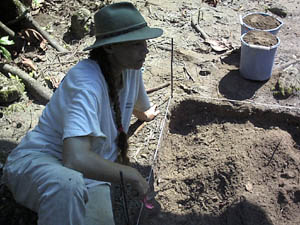
Felicia Beardsley
The first thing we did this morning was to take pictures of Units 1, 2, 3, Nena's excavations. It is basically a three-meter-long trench, one meter wide through a rather extensive midden deposit. The midden is over 70 cm thick, which translates to about two feet. It is turning up the full range of materials we are both recovering: bird and fish bone, fire-cracked rock (used as cooking stones), shell (definitely food shell, but it also debris from tool making), coral (lots of branch coral in particular, which now takes on a new meaning; it is quite possible that it is the raw material for the manufacture of fishhooks), and charcoal. Nena expects to complete the excavation of this compound unit today, so after pictures, he and I went off to scout out a new location for him while his crew continued the excavations.
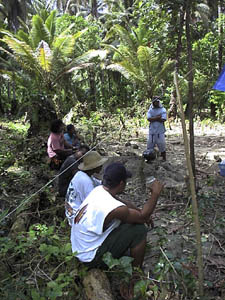
Morning coffee
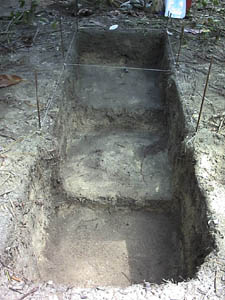
Walung Units 1, 2, and 3
His new unit, we decided, would be in a shell workshop. Our decision was practically made for us when we were standing in the general vicinity of an area that had produced a couple of shell flakes and an adze preform during our initial reconnaissance across the site. As we were talking, I looked down at the ground and found that it was covered in shell flakes. Large and small flakes, all from the giant clam shell Tridacna. Everywhere you turned there were more and more flakes visible. Unit 5 would go here. My crew, in the meantime, continued excavations in Unit 4. We got through five levels by the end of the day, leaving the unit profile for tomorrow morning. At level 3 we encountered what could be a post or stake mold, a small circular discoloration of soil with a long thin rounded profile once the soil had been removed. Of course, it could also be a crab hole; we cannot rule out that possibility. Crab burrows are ubiquitous here and cause us no end of worry, whether we are walking across the site or digging through it. You can easily step into one; you can have an excavation wall collapse on you (the soil that fills the crab burrows is not compacted); or you can you can work yourself into a state wondering just how much material has been transported up or down a deposit of midden. In the case of our possible post mold, I treated it as if it were the genuine article (it is possible, you know) and used it as a training exercise for my guys.
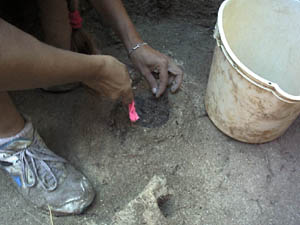
Post hole
Compared to yesterday, today was rather dull. As usual, Junior swiped my camera and went around taking pictures. I think he was instructing some of the guys in its use, as there were also pictures of Junior that I am pretty sure I did not take.
July 15, 1999
 This is our last day. The contract for the crew ends today, and they were just getting really good at the work, and interested. Today, though, provided a marvelous finish for us as a group. I still have to return next week to do some final odds and ends, including filling in those units we have opened. I did not want to do that today, but opted instead to have the guys continue with our excavations. The day began on a propitious event: Burdy caught a fish on our walk to shore from the boat. It was another fish caught with bare hands; this one, he said, was trying to hide in a small crevice in the corals on the reef flat. He grabbed it before it could escape. This is our last day. The contract for the crew ends today, and they were just getting really good at the work, and interested. Today, though, provided a marvelous finish for us as a group. I still have to return next week to do some final odds and ends, including filling in those units we have opened. I did not want to do that today, but opted instead to have the guys continue with our excavations. The day began on a propitious event: Burdy caught a fish on our walk to shore from the boat. It was another fish caught with bare hands; this one, he said, was trying to hide in a small crevice in the corals on the reef flat. He grabbed it before it could escape.
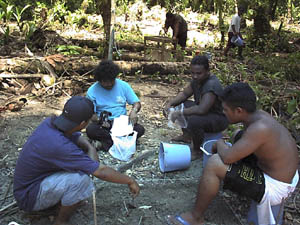
Nena talks over the day's work with the crew
Nena began and completed Unit 5 in the shell workshop. It proved to have a great many roots, which he and his crew were not particularly happy about; however, with root clippers in one hand and trowels in the other, they managed to get through it. The midden deposit here was less than 20 cm deep, and seemed to consist of shell debris. As his unit was closer to where me and my crew were working, we shifted the screen to a point between us; much closer than its last location. We simply had to step over a couple of coconut logs to get to it; Nena had a much straighter path with fewer obstacles.
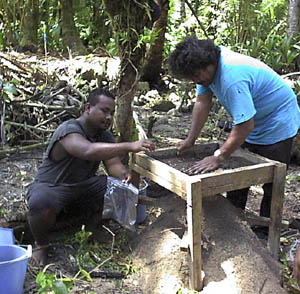
Unit 5 screening
At Unit 4, we completed the profile of the unit as a whole. Well, I suppose I shouldn't say "we". My task was to define the stratigraphy on one of the walls, while Burdy defined it on the adjoining wall. Then he and Junior went about recording the profile. While they were doing that, I selected a small area for our next and final excavation, Unit 6.
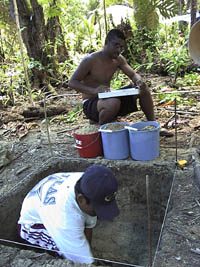
Jun and Burdy in Unit 4
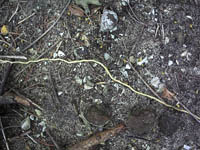 I selected a heavy dark midden concentration just beyond Unit 4, a possible kitchen area, perhaps for the structure by which Unit 4 was placed. I selected a heavy dark midden concentration just beyond Unit 4, a possible kitchen area, perhaps for the structure by which Unit 4 was placed.
A tree was growing in the middle of the midden, in what looked like its thickest, darkest part. I would almost expect that, however, as the midden would provide a nice rich soil. I laid out the unit, between roots. And we began the excavations as soon as the profile was completed in Unit 4.
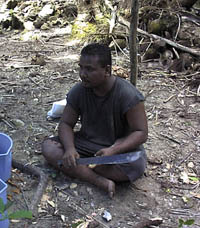
Yos carving at Unit 5
This little unit turned out to be a treasure. It was not only thick with charcoal, bone and fire-cracked rock, but we also recovered Tridacna flakes, coral tools of a type Nena says has never been recovered before on the island, and from the screen a beautifully executed diamoned-shaped bead or ornament with beveled edges on one side. (Nena said he had never seen this sort of bead or ornament on the island; it is something else that is new.) Burdy found the ornament in the screen and was nearly beside himself. Junior, for his part, came across the coral tools during the excavation. One of the tools is a soft coral, but it has compression marks where it was grasped during use. Each of the guys in turn had to hold the tool, try holding it in different ways, and yet would always come back to the initial pattern established by the compresssion marks. As with the last unit, I was not allowed to dig. These guys know what they are doing. The midden was roughly 40 cm deep, but thick, really thick, dark and greasy.
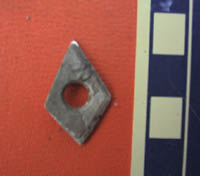
Ornament from Unit 6 --- Front |
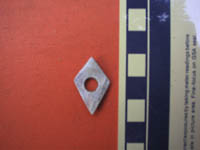
Ornament from Unit 6 --- Back
|
We had a good day. We recovered still more artifacts that are new to the archaeological inventory of the island. This site is a wonder, and now I can hardly wait to start the labwork, which will mean sorting through the midden and materials we have recovered from each of the units we excavated. It will be through the lab, I think, that we will gain many more insights into the unique character of this place: its coral fishhook industry, its unique shell ornament manufacture, its body of coral tools. What does it all mean? I have to give some thought to that over the weekend. Next week, not only do I return to fill in open excavations, but also to give a tour to the ninth-grade class. All the ninth-graders on the island have a week of educational enrichment, and will be visiting various historical sites as well as natural sites, such as mangroves, plantations and whatnot. They will be hiking around the island, stopping in Walung for a visit to this site on the 21st.
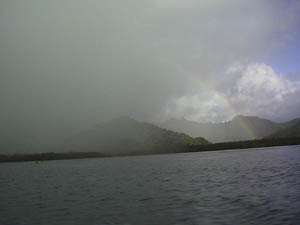
Our day ended with the approach of rain. We watched it come over the mountains on our boat ride back to the docks, a rainbow on its advancing edge.
July 19, 1999
To Walung with Berlin and Lupalik; Nena is busy acting as tour guide for the ninth-graders and their tour around the island. We simply filled in about half the excavations in the site, leaving three open for the ninth-grade tour on Wednesday. It rained all day today, and the three of us got thoroughly soaked. Yet it turned out to be an enjoyable day, as Berlin and I talked our way through most of it. We talked a lot about this site. He said he was ready to dismiss it as something that was wholly disturbed, having been the site of pig pens and a place that had been mined over the years by the locals for building materials. But, as soon as he saw the amount of materials we recovered, he changed his mind. There was something to this site, he decided; it is a unique site in the history of Kosrae.
First and foremost, it has supported a material industry unknown anywhere else on the island, complete with coral fishhooks, various and unique kinds of coral tools, shell ornaments, and midden deposits in such quantity as has never been seen to date, and a Tridacna shell workshop that supported an adze industry. It is a rich site, if our recovery is any indication. We excavated 5.5 square meters, out of 6,150 square meters just inside the walls of the compound; that is .09 percent of the area, or less than 1/10 of 1 percent. If we really wanted to make this figure sound dramatic, then we could include the entire site area, which would encompass the surrounding compound wall and enclose an area of 8,500 square meters (our recovery would then drop to .06 percent of the total site area).
So how do we even begin to interpret it?
Safonfok, Walung, this Fortress of Solitude, is a site outside oral history. There is no oral history to cover the site; it doesn't appear in historical texts, and there is no mention of it in the oral histories recorded today. Although to be frank, its absence in oral history doesn't necessarily mean it is old; it simply means that the people who knew about this site are no longer around. Still, its absence from historical texts suggests it is something from more distant and remote times, long abandoned and forgotten before the time oral history begins and before it could be relayed to the earliest explorers who set foot on the island.
Its location, on the coastal plain at a point where the reef meets the shoreline, provides a somewhat strategic position that allows the inhabitants to see all comings and goings inside and outside the reef. A channel that drains into the lagoon follows a course that takes it to the inland side of the site. (There might be a canoe landing off this channel; something to look for in the future.) This provides yet another mechanism for isolating the site. It is a large site, among the largest on the island; Berlin was saying there are somewhat larger compounds just to the north, on this same coastline, so it would seem that the west coast of the island at one time supported larger compounds than have been observed elsewhere. Its surrounding walls were probably 3 to 5 meters high, and its isolation, the only site in this area, suggests it was of some importance. It was probably pre-Leluh, and likely constructed long before the density of sites began to grow in this general section of the island (on the volcanic slopes that is, not on the coastal plain).
From all appearances, this was probably an administrative site or the focus of a community, where the higher-ranked persons dwelled, leaving the lower-ranked outside the walls; it appears to be the center of an adze-making industry, and time and labwork will be able to tell us more than that. From the materials we have so far, we should be able to reconstruct at least in outline form the daily patterns of life, the general activities at the site, the general arrangement of living areas, what people were eating and how they were cooking, what sort of implements and ornaments they were producing. With the exception of some basalt boulders in the wall debris and a few basalt cobbles among the fire-cracked rock, all the materials recovered from the site are from the sea: shell and coral.
No pictures today owing to the rain.
July 20, 1999
In the office today, where we begin to sort through the midden. This is the first rough sort, intended to divide each sample bag into gross material categories (coral, bone, shell, charcoal, fire-cracked rock), with at least one category reserved for the unusual items that need a more intensive examination and recognizable artifacts. Angunis and Kerrick are helping with this, when they are not off fulfilling their own responsibilities. It is this activity (and a more detailed lab analysis to follow) that will assist in a more complete interpretation of the site. It is through this piece-by-piece sort that we should begin to see materials with various modifications that cannot be attributed to nature alone.
We were rewarded, too. In one of the bags Kerrick started sorting, he came across several modified pieces of branch coral, all of which looked like fragments of compound fishhook shafts. We are also finding shell flakes and some cut shell.
I spent my time going between the labwork and preparations for tomorrow's site visit by the 9th graders. Berlin and Lupalik are going to go along, and help fill in the remaining opened units after the kids get a chance to look at them.
July 21, 1999
Today is our last trip to Walung. It is rather a sad day in that regard. This has been a wonderful site to work, and it deserves much more work. It needs to be more fully mapped, and it needs more extensive excavation. Our work can only be considered preliminary, but we have been able to show that this is a rich site, and one that has produced an entirely new technological industry.
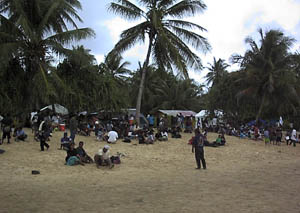
Walung tour for Kosrae ninth-graders
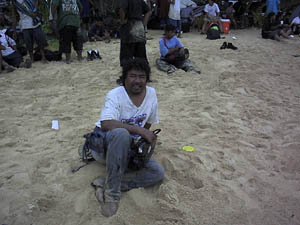
Nena, as tour guide
The ninth-graders, I think, were probably overwhelmed. No one said anything or asked questions, but here in Micronesia, you almost expect that. If you have any effect at all, you generally don't hear about it directly, but rather in a roundabout fashion. They were polite and listened; they were surprised to find that they were actually seated next to a coral foundation; and they even helped to fill in the stratigraphic trench I left open for their review. It was the trench that displayed all the various soil layers of the site, from the area's initial appearance as an active sand beach layer with comminuted shell and sand pulverized to little bits by the action of the waves and water, through its build-up as an island with stabilized sand and vegetation cover, to its use as a human habitation in the form of this large but isolated compound, to its current circumstance of general abandonment where the vegetation is once more contributing to the build-up of the soil.
July 22, 1999
More midden sorting today. It was mostly just Kerrick and I; Angunis was busy with office stuff. We have some worked bone turning up in our midden, displaying marks that look unrelated to eating. They are cutting and scraping marks that really need a more intensive, and magnified, examination. I don't know if this is something new to the island's archaeological record or not (the coral fishhook industry most definitely is). Stan seems to think the worked bone is a new element in the archaeological record; he is in the hospital with tests being run on his knee. I visited him there today, and gave him a summary of what we have been finding hidden in the bags of midden.
July 26 to 28, 1999
More labwork. We are continuing to find new items. In addition to the coral fishhook fragments, we are finding drill bits of coral and basalt, coral files, shell cut in intricate patterns, a possible netsinker of coral that displays cordage marks at one end where the attached line had been wrapped to secure the sinker, drilled shell fragments, a possible drilled bone, and shell and coral flakes. For a rapid sort, this is turning into an impressive array of articles. From all appearances, it seems that much of the reduction work on shell and coral was taking place in what was likely the center of activities, the cooking areas. These are the areas where the majority of manufacturing debris are occurring. I can just imagine people sitting around their um, working on a fishhook or netsinker or shell ornament while talking and gossiping with those nearby, each of whom in turn are also probably doing some sort of production work, such as grinding a shell, shaping a piece of coral or drilling a hole in something.
Next: Senior Fair, Village Resort, site inspections
|
|
|